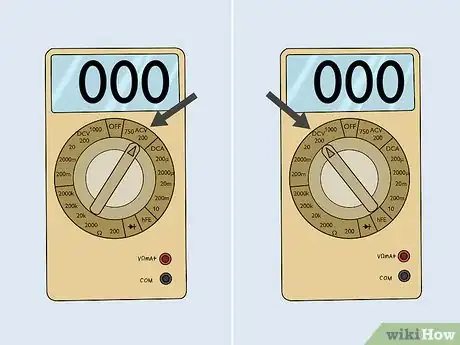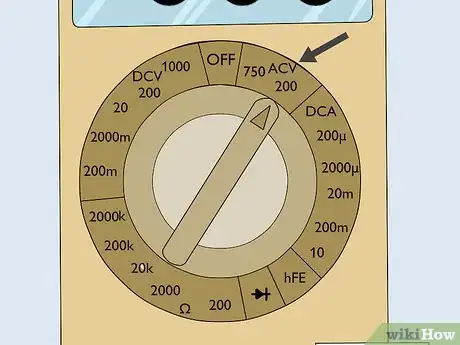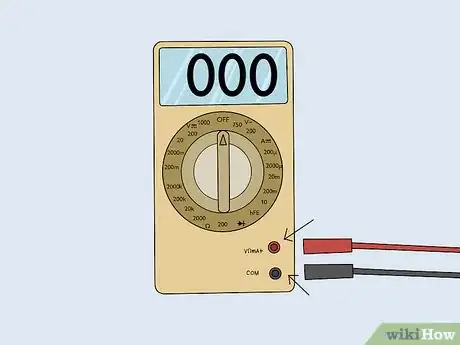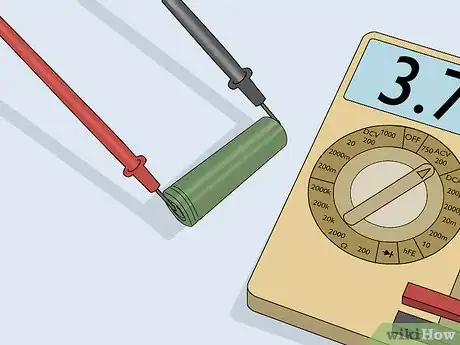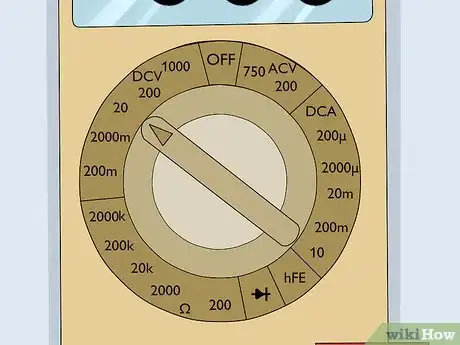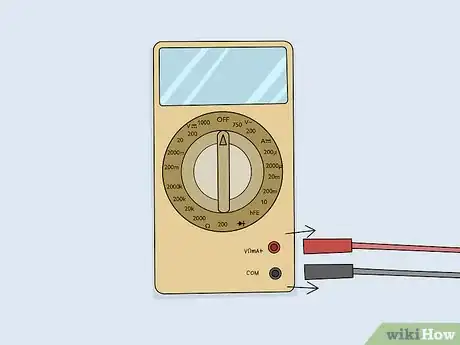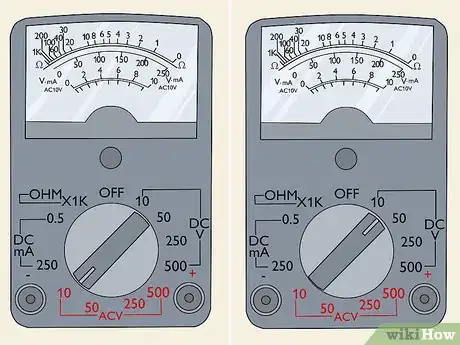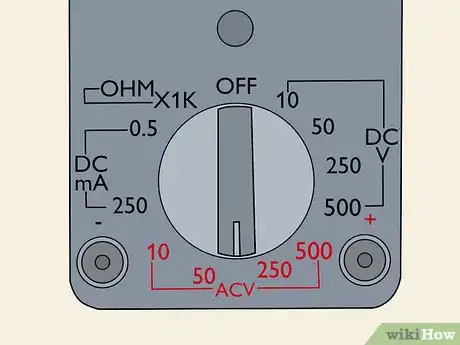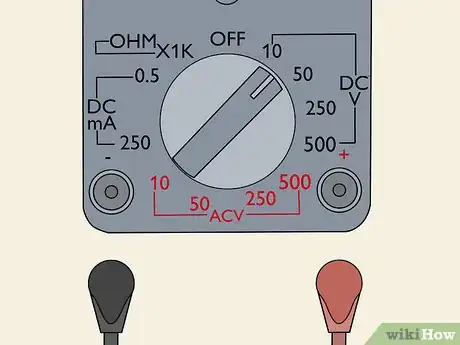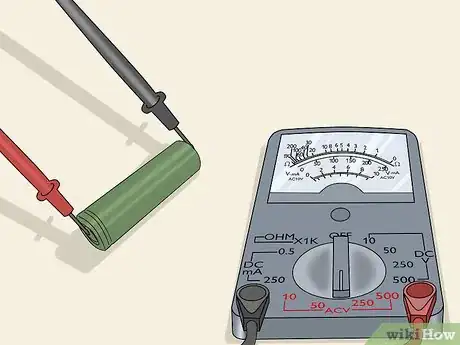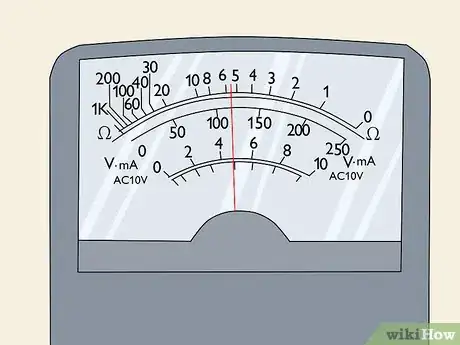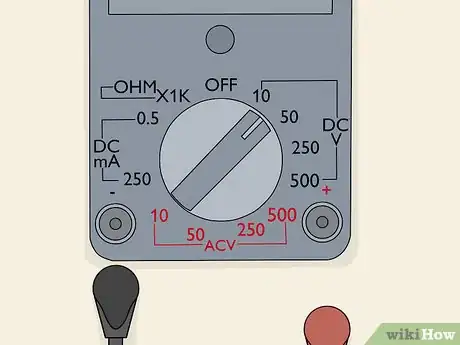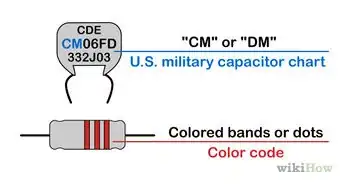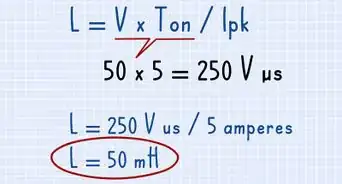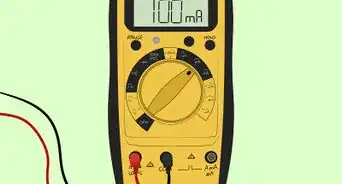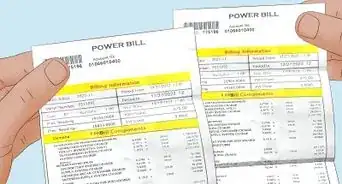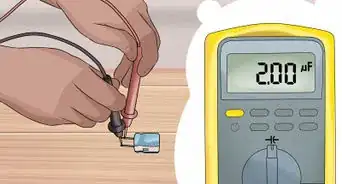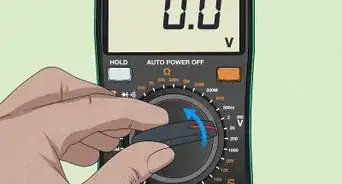This article was co-authored by Ricardo Mitchell. Ricardo Mitchell is the CEO of CN Coterie, a fully licensed and insured Lead EPA (Environmental Protection Agency) Certified construction company located in Manhattan, New York. CN Coterie specializes in full home renovation, electrical, plumbing, carpentry, cabinetry, furniture restoration, OATH/ECB (Office of Administrative Trials and Hearings/Environmental Control Board) violations removal, and DOB (Department of Buildings) violations removal. Ricardo has over 10 years of electrical and construction experience and his partners have over 30 years of relevant experience.
This article has been viewed 66,894 times.
If you’ve never tested voltage with a multimeter before, you might be staring at all of the different numbers, symbols, and buttons on the device and wondering what exactly you’re supposed to be doing with them. Don’t worry! This article will walk you through the entire process step-by-step, whether you’re using a digital or analog multimeter.
Steps
Using a Digital Multimeter
-
1Set the multimeter dial to AC or DC mode. The symbol for direct current (DC) is a V with 3 dots or a dash above it. It can also be labeled as DCV or something similar. An alternating current (AC) setting is often labeled with a V and a squiggly line or initials like ACV. Turn the dial to the type of current you plan on measuring.[1]
- DC is common in batteries and other low-voltage sources of power. AC is used in buildings, electronics, and anything else that requires multiple currents.
-
2Select the voltage range if it can be set manually on the dial. On some multimeters, you will see a bunch of numbers around the dial. If yours has these numbers, refer to the electronic device you are testing or check the user manual for the normal voltage it is supposed to have. Then, set the multimeter dial to the next highest setting. Estimating the voltage this way makes the test result more accurate.[2]
- For example, if you have a 12V battery, test it using the 20V setting. Using any settings beyond that would lead to a less accurate result.
- Most modern multimeters are autorange, meaning they set the proper range once you begin the test.
- If you’re not sure what voltage setting to use, start at the highest one. Work your way back until you get an accurate result. The voltage readout will change to 1 if you go too far.
Advertisement -
3Plug the colored probes into the slots on the multimeter. Every multimeter has a red and black probe. The black probe always fits into the COM port on the front of the multimeter, so insert that one first. The remaining ports, marked 10A and mAVΩ, are meant for the red plug. Choose the one that fits the kind of current you plan on testing.[3]
- The mAVΩ port is meant for currents rated at 200 milliamps (mA). In most cases, you will end up using this port.
- Use the 10A port to test strong currents greater than 200 mA. If you don’t know the strength of the current you are testing, plug the red probe into the 10A port to avoid damaging the multimeter.
-
4Connect the test leads to the circuit you wish to test. Connect the black probe first. Touch it to the negative terminal if you’re testing a device with one. Then, touch the tip of the red probe to the opposite terminal or end of the circuit. The multimeter’s display will change as the current flows through it.[4]
- To get accustomed to using a multimeter, test it on a battery. Hold the black probe against the negative terminal and the red probe against the positive one.
- If you’re attempting to test live wires, find the screws pinning the wires in place. Touch the black probe to one screw and the red probe to another.
- Be careful to avoid touching active wires or metal parts, since it could lead to an electrical shock. Also, the multimeter could short-circuit if you bump the metal tips of the probes together.
-
5Adjust the multimeter as needed to get an accurate reading. The multimeter display will change as soon as it detects the active circuit. If you set the dial to the correct setting, you won’t need to do anything else. If you’re not sure what the test subject’s normal voltage is supposed to be, turn the dial down gradually until get an accurate result. If you set the voltage too low, the multimeter will display 1.[5]
- The multimeter range has to be set to the correct maximum voltage for the circuit in order to get the most accurate result possible. If it is set too high, it will have a hard time detecting the voltage of a weaker current.
- If the multimeter displays a negative number, for example, the probes are most likely in the wrong place. Reverse them so that the electrical current flows properly between them.
- If you don’t see any readout, the circuit may not be receiving any electrical power at all. Test the multimeter on something active, such as a battery or outlet, to make sure it still works.
-
6Remove the red and black probes to shut off the multimeter. Pull the red probe away from the circuit, then take away the black one. Handle them with caution to avoid coming into contact with the metal tips or bumping the probes together. When you’re ready to stop using the multimeter, unplug the probes by removing the red one first and the black one second.[6]
Testing with an Analog Multimeter
-
1Change the multimeter to test an AC or DC current. Turn the dial to the proper setting. The AC setting is often indicated by a straight line or a label live ACV. The DC option usually as a series of dots or a label like DCV. The setting you need will depend on what you are testing.[7]
- Use the AC setting to test wall outlets and most electronic devices. DC is for batteries and other low-voltage power sources.
-
2Select a high range on the dial for the test. Choose a range according to the regular voltage of the device you wish to test. The voltage is printed on some devices and included in the user manual on others. To get an accurate result while protecting the multimeter from damage, set the dial at the next highest voltage setting available.[8]
- For instance, most home outlets maintain a 120-volt current. Set the multimeter to 200v or the next closest setting above 120.
- Most multimeters have fuses that protect them from serious damage, although inexpensive ones sometimes don’t. Using the wrong setting could destroy the multimeter.
- If you’re unsure what setting to use, start at the highest one and move down until the multimeter reacts.
-
3Plug the probes into the ports on the multimeter. Look for a pair of open ports on the bottom left and right corners of the multimeter. The slot marked as -COM is meant for the black probe. Plug the red probe into the slot marked with a plus sign.
- If you reverse the probes, you won't get an accurate test result. If you notice the multimeter needle moving in the wrong direction, check the probes first.
-
4Touch the ends of the probes to the device you are testing. Use the black probe first, holding it to the negative terminal if the device has one. Then, touch the red probe to the positive terminal. Be careful not to touch the metal tips of the probes or any active electrical components that could shock you.[9]
- You can test the multimeter using a battery first. The positive and negative terminals on the battery are labeled and easy to spot.
- Handle the probes one at a time to avoid touching the tips and short-circuiting the device.
-
5Check the meter and adjust it to get an accurate reading. Analog multimeters have a needle that moves to measure voltage. Watch for the needle to move toward the voltage numbers printed on the multimeter. Analog multimeters also have separate rows of numbers labeled for AC and DC settings, so make sure you’re looking at the correct one. Note the measurement, then consider doing the test a couple more times to ensure you got an accurate reading.[10]
- If the needle doesn’t move much, turn the multimeter’s voltage setting down a little bit. It often doesn’t react when the voltage setting is too high. Also, make sure the testing device is active.
- If the needle moves all the way to the right, pull the probes out. Set the multimeter dial to a higher range, then perform the test again. Try to avoid having this happen, since it could damage the multimeter.
-
6Unplug the multimeter probes when you’re done. Pull the red probe out first, followed by the black probe. Handle them carefully so the metal tips don’t come into contact with one another. When you’re done, you can also detach them from the multimeter.
Expert Q&A
Did you know you can get expert answers for this article?
Unlock expert answers by supporting wikiHow
-
QuestionWhen you test a broken fuse, what will it read on the multimeter?
 Ricardo MitchellRicardo Mitchell is the CEO of CN Coterie, a fully licensed and insured Lead EPA (Environmental Protection Agency) Certified construction company located in Manhattan, New York. CN Coterie specializes in full home renovation, electrical, plumbing, carpentry, cabinetry, furniture restoration, OATH/ECB (Office of Administrative Trials and Hearings/Environmental Control Board) violations removal, and DOB (Department of Buildings) violations removal. Ricardo has over 10 years of electrical and construction experience and his partners have over 30 years of relevant experience.
Ricardo MitchellRicardo Mitchell is the CEO of CN Coterie, a fully licensed and insured Lead EPA (Environmental Protection Agency) Certified construction company located in Manhattan, New York. CN Coterie specializes in full home renovation, electrical, plumbing, carpentry, cabinetry, furniture restoration, OATH/ECB (Office of Administrative Trials and Hearings/Environmental Control Board) violations removal, and DOB (Department of Buildings) violations removal. Ricardo has over 10 years of electrical and construction experience and his partners have over 30 years of relevant experience.
Electrician Professional, CN Coterie
Warnings
- Working with live electrical circuits is dangerous, so perform tests with caution. Never touch live wires or outlets. Hold the multimeter probes by the plastic ends to avoid touching the exposed metal tips and short-circuiting the device.⧼thumbs_response⧽
- Make sure you set the multimeter to test volts at the proper range. Using the wrong settings could damage the device!⧼thumbs_response⧽
References
- ↑ https://www.sciencebuddies.org/science-fair-projects/references/how-to-use-a-multimeter
- ↑ https://www.bobvila.com/articles/how-to-use-a-multimeter/
- ↑ https://sciencing.com/use-centech-digital-multimeter-6101228.html
- ↑ https://www.bobvila.com/articles/how-to-use-a-multimeter/
- ↑ https://myslu.stlawu.edu/~jmil/physics/labs/common/multimeter.pdf
- ↑ https://www.sciencebuddies.org/science-fair-projects/references/how-to-use-a-multimeter
- ↑ https://sciencing.com/use-centech-digital-multimeter-6101228.html
- ↑ https://cie-wc.edu/AnalogMultimeter_MeasuringDCVoltage_10-18.pdf
- ↑ https://sciencing.com/use-analog-multimeters-8297477.html
